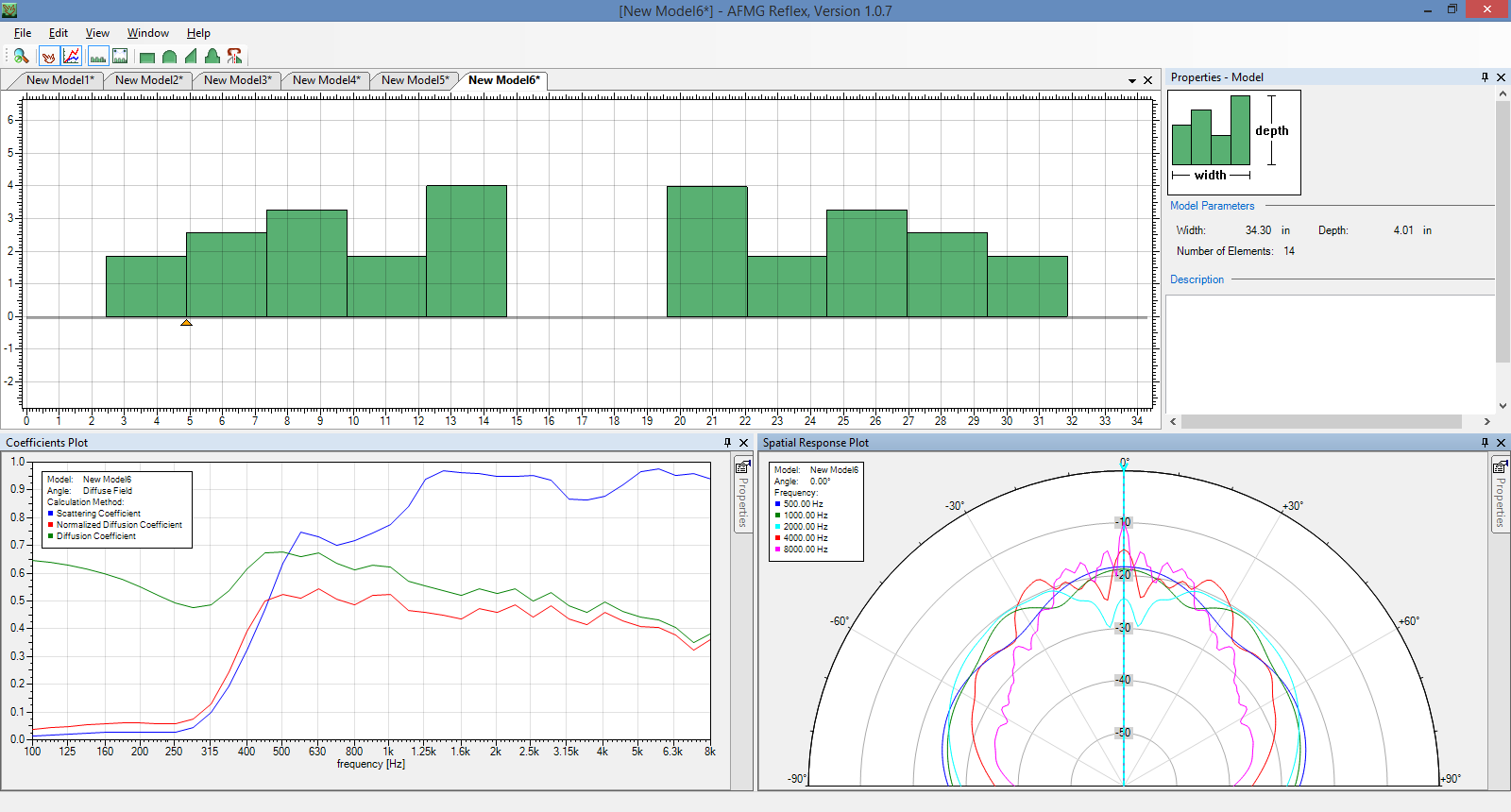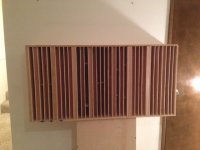I should start off by saying I don't know if this is a good place to put this thread. diyAudio doesn't have a forum for DIY acoustics (hey, why doesn't it?).
Anyway, I wanted to show an EASY and inexpensive way to make sound diffusers (at least if you are in USA, near a Home Depot or similar store). These are based on a design and construction method for the "LeanFuser" by Tim Perry of Arqen Sonic. See Tim's site and his free designs at Sound Diffusers 101: Free Designs for DIY Diffuser Panels. Definitely a good read, and Tim seems to know what he's doing (the LeanFuser was developed in the course of his thesis on computer optimization of step diffusers).
I started with Tim's basic idea, but optimized it (using his directions and the software he recommended) for a wider 35" diffuser, about 4.6" deep, and using readily available and very cheap wood available at Home Depot. I got the wood there, had Home Depot cut the wood (free) for qty5 20" high diffusers, and, with an electric 1.25" brad gun, built the diffusers in about an hour! That's faster than I could make absorbers. Add time if you want to finish or polyurethane them, of course. The time spent picking out fairly decent looking wood pieces at the store and having them cut was also kind of time consuming. If you don't have or don't want to buy a brad gun and don't mind a more time consuming project, you could also of course assemble using nails, screws, glue, or whatever.
Here's the basic cross-section plan for the "Depot Diffuser" design. It should be pretty self-explanatory, build it as tall as you like.

Here's a (crummy phone) photo of some of them set up in my in[progress basement sound room. They made a remarkable improvement to the sound there, more than filling the celing beams above with rockwool -

In case you know how to interpret the simulation data on the design (I'm n sure I know much how to, btw), here is what "AFMG Reflex" (diffuser simulation) software says the performance is like:

Happy building!
Anyway, I wanted to show an EASY and inexpensive way to make sound diffusers (at least if you are in USA, near a Home Depot or similar store). These are based on a design and construction method for the "LeanFuser" by Tim Perry of Arqen Sonic. See Tim's site and his free designs at Sound Diffusers 101: Free Designs for DIY Diffuser Panels. Definitely a good read, and Tim seems to know what he's doing (the LeanFuser was developed in the course of his thesis on computer optimization of step diffusers).
I started with Tim's basic idea, but optimized it (using his directions and the software he recommended) for a wider 35" diffuser, about 4.6" deep, and using readily available and very cheap wood available at Home Depot. I got the wood there, had Home Depot cut the wood (free) for qty5 20" high diffusers, and, with an electric 1.25" brad gun, built the diffusers in about an hour! That's faster than I could make absorbers. Add time if you want to finish or polyurethane them, of course. The time spent picking out fairly decent looking wood pieces at the store and having them cut was also kind of time consuming. If you don't have or don't want to buy a brad gun and don't mind a more time consuming project, you could also of course assemble using nails, screws, glue, or whatever.
Here's the basic cross-section plan for the "Depot Diffuser" design. It should be pretty self-explanatory, build it as tall as you like.

Here's a (crummy phone) photo of some of them set up in my in[progress basement sound room. They made a remarkable improvement to the sound there, more than filling the celing beams above with rockwool -

In case you know how to interpret the simulation data on the design (I'm n sure I know much how to, btw), here is what "AFMG Reflex" (diffuser simulation) software says the performance is like:

Happy building!
Last edited:
Hi bwaslo
Super cool. Congratulations with the build.
I can only encourage to build diffusors .... next to speakers room treatment, and especially diffusors are the most significant way to improve the sound
My own attempt:
DIY Diffusor | Baldin's Blog
/Baldin
Super cool. Congratulations with the build.
I can only encourage to build diffusors .... next to speakers room treatment, and especially diffusors are the most significant way to improve the sound
My own attempt:
DIY Diffusor | Baldin's Blog
/Baldin
Sy, Thanks.
Baldin, Yours look really cool, too. I also noticed the same perceived results as you mentioned -- much greater detail and image depth, and the room seems larger and just more pleasant overall.
Baldin, Yours look really cool, too. I also noticed the same perceived results as you mentioned -- much greater detail and image depth, and the room seems larger and just more pleasant overall.
If only my wife would allow me. Sigh. I showed her some of the RPG-style diffusors in Alton Everest's book and she explained to me what "castration" means.
I have a small window of opportunity whilst mine is learning how to make sofa covers. She can practice on covering up the diffusors.
Hmm my bookcase is deeper than the books on it. wonder if wibbly lines of books will get past the scrutiny.
Hmm my bookcase is deeper than the books on it. wonder if wibbly lines of books will get past the scrutiny.
Nice approach, but building them this way decreases the effectiveness (perhaps too much) by not having the separator fins between the steps. These are required so that separate reflections from each step combine well off the diffuser causing phase cancellation.
I've not had a chance to read the thesis on his website yet, so how much of an increase do the fins give in measurement or simulation?Nice approach, but building them this way decreases the effectiveness (perhaps too much) by not having the separator fins between the steps. These are required so that separate reflections from each step combine well off the diffuser causing phase cancellation.
I've not had a chance to read the thesis on his website yet, so how much of an increase do the fins give in measurement or simulation?
According to what's on 'Acoustic absorbers and diffusers" (Cox & D'antonio), most of the effect of diffusion is lost if each step of the baffle isn't separated from the adjacent one with enough depth. Without the "fins" you get what's commonly called "skyline" diffuser. Common for 2D diffusers as it is very complex to build the complete profile for them, but their effect is seriously reduced.
But the performance can be modeled (and that statement can be seen NOT to be so!). The advantage of separators is that the performance can be mathematically designed and predicted. See a later paper by Cox: http://www.rpginc.com/docs\Technolo... Diffusers_The Good, The Bad and The Ugly.pdf
...particularly section 4, "IS A QRD DIFFUSER UNIQUELY MAGICAL?":
...which leads us to step diffusers which are easier to make, require less wood, less weight, and have lower acoustic losses. Download the eval copy of AFMG Reflex and model a QRD or other well-type diffuser and compare.
...particularly section 4, "IS A QRD DIFFUSER UNIQUELY MAGICAL?":
"the surface construct".. (arranging the surface as a series of wells) .."is a convenience to achieve a mathematical aim, it is not unique in being able to produce scattering."
"The problem is that once a design moves away from a series of wells, to steps, curved or fractal constructions, then the simple design equations are no longer applicable. In that case, a standard engineering solution, numerical optimisation, is used whereby a computer searches for the best possible diffuser shape. At this point the surface can be any arbitrary shape."
"The problem is that once a design moves away from a series of wells, to steps, curved or fractal constructions, then the simple design equations are no longer applicable. In that case, a standard engineering solution, numerical optimisation, is used whereby a computer searches for the best possible diffuser shape. At this point the surface can be any arbitrary shape."
...which leads us to step diffusers which are easier to make, require less wood, less weight, and have lower acoustic losses. Download the eval copy of AFMG Reflex and model a QRD or other well-type diffuser and compare.
Last edited:
According to what's on 'Acoustic absorbers and diffusers" (Cox & D'antonio).
So you didn't go to the linked webpage to look at the guys PhD research and note that the diffusors in the OPs room were optimised to be able to be built by anyone with access to home depot (or similar), with published results?
Personally even if they are 20% less effective than RPGs best (and I doubt they are) then the ease of construction and the fact that you can simulate and adjust the response is a small price to pay.
Thanks for the link Bwaslo - very interesting indeed - will 'knock one up' and compare with a basic 1D Schroeder - could easily bend the 2 top profiles up on a sheet metal bender and fill the hollows with expanding foam, tontine, insulation batts, etc but maybe create a 'top end' problem ...
If only my wife would allow me. Sigh. I showed her some of the RPG-style diffusors in Alton Everest's book and she explained to me what "castration" means.
You could just paint them the same as the wall cover in the room. If they were made floor-to-ceiling, I don't think they would clash too much with most WAF standards. Or make shorter ones and stretch some burlap or other porous fabric over them. Would probably look decent to her, at least compared to the fuglyness of most audio gear!
BTW, here are web links for the Home Depot wood pieces, so people can find the right ones (assuming they are near a Home Depot store):
http://www.homedepot.com/p/Unbranded-Furring-Strip-Board-Common-1-in-x-3-in-x-8-ft-Actual-0-656-in-x-2-375-in-x-96-in-164704/100088011?N=5yc1vZbqmc
http://www.homedepot.com/p/Unbranded-Furring-Strip-Board-Common-1-in-x-2-in-x-8-ft-Actual-0-656-in-x-1-468-in-x-96-in-160954/100075477?N=5yc1vZbqmc
http://www.homedepot.com/p/Unbranded-Sanded-Plywood-FSC-Certified-Common-11-32-in-x-4-ft-x-8-ft-Actual-0-322-in-x-48-in-x-96-in-577138/100053860?keyword=577138
Last edited:
The biggest challenge for me will be the back wall. Due to room size the sofa is pushed against the wall. One day will find an acceptable solution for it.
But what sort of diffuser? The ones in the OP are specifically stated as 'not for back wall', and the RPG 3D ones would cause me to join SY in the castration queue!
did somebody try out qrdude? i played around with it a while ago and think its very clearly laid out. as i can remember there was some limitation with maximum size of very big diffusors, so in this case you had to calculate modulo by hand.
QRDude: Quadratic Residue Diffuser calculator
QRDude: Quadratic Residue Diffuser calculator
http://www.diyaudio.com/forums/mult...loudspeaker-spatial-sounding.html#post4157334
The bamboo room divider which graaf suggested in the link above looks very good for this application.
The bamboo room divider which graaf suggested in the link above looks very good for this application.
- Status
- Not open for further replies.
- Home
- General Interest
- Room Acoustics & Mods
- DIY sound diffusers
